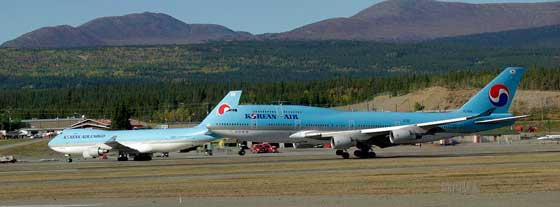Major 9/11 questions still unanswered, film shows
When Max Fraser started collecting footage and stories about how Sept. 11, 2001 played out in the Yukon's capital,
By Justine Davidson on April 25, 2011
When Max Fraser started collecting footage and stories about how Sept. 11, 2001 played out in the Yukon's capital, he set out to make a point-of-view documentary about the terrifying spectre of a supposedly hijacked jumbo jet landing in – or on – Whitehorse.
Already, images of two American Airlines jets slamming into the World Trade Center in New York City were being beamed to television sets around the world.
And what Fraser ended up with is the mysterious tale of how Korean Air Flight 085, bound for New York City, came to land at the then-Whitehorse International Airport at 11:54 a.m. that day, instead of descending at one of the many better-equipped Alaskan runways it passed on its way here.
And even more mysterious is why the plane was transmitting a hijack "squawk” (a satellite code which can be discretely set by a pilot to alert authorities on the ground of a hostile takeover), even though all was well on board.
As one of the many parents scrambling to find their children after learning that every student in Whitehorse was being evacuated from school, Fraser was inspired to make the 45-minute documentary.
For the local filmmaker, it was a way of answering at least some of the many questions he had in the weeks, months and years following the deadliest terrorist attack ever committed on North American soil.
"Nowhere else in the world on 9/11 was a community under an evacuation order and nowhere else were emergency authorities told to prepare for a mass casualty incident involving a hijacked airliner,” Fraser said of the film's premise. "What we experienced, what we went
through, is a story that should be told the world over.”
He began by interviewing other parents who rushed to Whitehorse Elementary School as government buildings emptied and the streets filled with people trying to get out of town.
He also filed a number of access to information requests to the Canadian and American governments, trying to piece together the timeline of what was happening in the air above.
He began with what Whitehorse residents knew that brilliantly sunny day – that a potentially hijacked 747 jet was headed their way.
This belief was based on reports from the RCMP, who were at the airport waiting for the huge airliner.
The RCMP, in turn, were working with information from North American Aerospace Defense Command (NORAD), which was tracking the Korean Air passenger jet.
The double-decker plane first started raising alarms at 9:06 a.m. Pacific Daylight Savings time, three hours and 21 minutes after American Airlines Flight 11 plowed into the north tower of the World Trade Center.
That was when the United States Federal Aviation Administration (FAA) was informed that a text message containing the code international code for hijacking – HJK – had passed between the cockpit of Flight 085 and Korean Air's ground control at 8:09 a.m. Although it was, and still is, unclear which end was sending the message, it was remarkable as the only such text message sent that day.
It was also remarkable for those monitoring the plane at the time because when ground control spoke to the plane's pilot, he reported all was well.
Meanwhile, U.S. vice-president Dick Cheney had authorized his country's war planes to "intercept civilian tracks of interest and shoot them down if they seem to be threatening a U.S. city. Clearance to shoot is authorized to save lives on the ground.”
In other words: If the Air Force brass believed a plane full of people was going crash into another American building, they were to blow it out of the sky.
The 230 souls on board Flight 085 had no idea they were being tracked by two fighter jets with shoot-to-kill authorization, and only the 747's crew knew what had happened in New York City to justify such an order.
In the three years Fraser spent investigating the orders and communications bouncing around North America that day, he has not discovered why the HJK text was sent, but he did uncover an even bigger mystery: Why did the FAA order Flight 085 to squawk 7500 – an unequivocal hijacking distress signal?
Using actual audio footage obtained through his information requests to the American military, Fraser shows the incredulous Korean Air pilot asking ground control to repeat what must have been an unbelievable order.
In the weeks and months after 9/11, once everyone knew Flight 085 carried nothing more threatening than airplane food, officials said the hijack signal was the result of language barriers – the pilot didn't speak very good English, they said, and wires got crossed.
"That's not true,” Fraser said bluntly at a press screening of his film last Thursday afternoon. "Anyone flying a 747 anywhere in the world speaks English.”
It is not a statement based on assumption. The retired RCMP commander who interviewed the pilot once the plane was grounded says the same thing to Fraser's camera.
Fraser weaves these surprising revelations with the recollections of parents and students of Whitehorse Elementary, who describe the confusion and terror of being stuck in traffic as the plane headed toward downtown.
Fraser's movie leaves the watcher with more questions than answers about the morning of Sept. 11.
Why did NORAD officials direct a supposedly hijacked plane to the city of Whitehorse when they could have ordered it to land in any number of Alaskan airfields?
Who sent the hijack text message and why?
Why was the pilot ordered to squawk 7500?
Why have officials been so reticent to explain their actions related to Flight 085?
The questions aren't answered, but they are certainly worth asking.
Never Happen Here will be screened at the Yukon Arts Centre at 7 and 9 p.m. Tuesday.

Be the first to comment